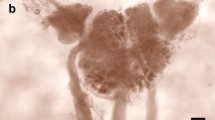Abstract
The expression of the early genes c-fos and c-jun were studied by blot hybridization in the central nervous system of the edible snail at the consolidation stage of a conditioned defensive reflex, with the aim of investigating genomic activity in neurons during learning. The c-fos gene was shown to be present in theHelix central nervous system, and its expression was shown to increase significantly during learning. Superinduction of the c-fos gene was observed in the presence of cycloheximide, a protein synthesis inhibitor. Corasol also induced this gene. Thus, induction of the c-fos gene inHelix can be induced by agents which induce it in higher vertebrates. This suggests that expression of the c-fos gene inHelix and in higher vertebrates is regulated by closely related mechanisms. Expression of the c-jun gene was insignificant, and definitive conclusions with regard to the role of this gene in learning cannot be drawn.
Similar content being viewed by others
References
L. N. Grinkevich, “Protein metabolism in the formation of a defensive response in mollusks,” Zh. Vyssh. Nerv. Deyat.,42, No. 6, 1221–1229 (1992).
L. N. Grinkevich, P. D. Lisachev, and M. B. Shtark, “Neurochemical correlates of plasticity,” Zh. Vyssh. Nerv. Deyat.,43, No. 5, 963–968 (1993).
T. Maniatis and J. Sambrook, “Molecular cloning,” in: Methods of Genetic Engineering [Russian translation], Moscow (1984).
C. M. Alberini, M. Ghirardi, R. Metz, and E. R. Kandel, “C/EBP is an immediate early gene required for consolidation of long-term facilitation,” Cell,76, 1099–1114 (1994).
K. V. Anokhin and S. P. R. Rose, “Learning-induced increase of immediate early gene messenger RNA in the chick forebrain,” Eur. J. Neurosci.,3, 162–167 (1991).
R. C. Armstrong and M. R. Montminy, “Transsynaptic control of gene expression,” Ann. Rev. Neurosci.,16, 17–29 (1993).
B. J. Bacskai, B. Hochner, M. Mahaut-Smith, et al., “Spatially resolved dynamics of cAMP and protein kinase A subunits inAplysia sensory neurons,” Science,260, 222–226 (1993).
P. M. Balaban and I. S. Zakharov, “Serotonin and aversive conditioning in adult and juvenile snails,” in: Cellular Mechanisms of Conditioning and Behavioral Plasticity, C. D. Woody (ed.), New York-London (1988), p. 105.
P. Chromczynski and N. Sacchi, “Single-step method of RNA isolation by acid guanidinium thiocyanatephenol-chloroform extraction,” Anal. Biochem.,162, 156–159 (1987).
A. J. Cole, D. W. Saffen, J. M. Baraban, et al., “Rapid increase of an immediate early gene messenger RNA in hippocampal neurons by synaptic NMDA receptor activation,” Nature,340, 474–476 (1989).
P. K. Dash, B. Hochner, and E. R. Kandel, “Injection of cAMP-responsive element into the nucleus ofAplysia sensory neurons blocks long-term facilitation,” Nature,345, 718–721 (1990).
S. Greenberg, U. Castelluci, H. E. Bayley, et al., “A molecular mechanism for long-term sensitization inAplysia,” Nature,329, 62–65 (1987).
B. K. Kaang, E. R. Kandel, and S. G. N. Grant, “Activation of cAMP-responsive genes by stimuli that produce long-term facilitation inAplysia sensory business,” Neuron,10, 427–435 (1993).
E. R. Kandel, M. Klein, V. Castelluci, et al., “Some principles emerging from the study of short- and long-term memory,” Neurosci. Res.,3, No. 3, 498–520 (1986).
M. Karin and T. Smeal, “Control of transcription factors by signal transduction pathway: the beginning and the end,” TIBS, 418–422 (October 1992).
L. Lentola, L. Sistonen, P. Koskinen, et al., “Constitutively activated new oncoprotein tyrosine kinase interferes with growth factor-induced signals for gene activation,” J. Cell. Biochem.,45, 69–81 (1991).
P. G. Montarolo, P. Goelet, V. F. Castelluci, et al., “A critical period for macromolecular synthesis in long-term heterosynaptic facilitation inAplysia,” Science,234, 1249–1254 (1986).
T. J. Nelson and D. L. Alkon, “Prolonged RNA changes in theHermissenda eye induced by classical conditioning,” Proc. Natl. Acad. Sci. USA,85, 7800–7804 (1988).
E. J. Nestler, B. T. Hope, and K. L. Widnell, “Drug addiction: a model for the molecular review basis of neural plasticity,” Neuron,11, 995–1006 (1993).
Additional information
Department of Medical Informatics and Electronics (M. B. Shtark, Director), Construction-Technical Institute of Computer Technology, Siberian Division, Russian Academy of Sciences, Novosibirsk. Translated from Fiziologicheskii Zhurnal im. I. M. Sechenova, Vol. 81, No. 8, pp. 24–28, August, 1996.
Rights and permissions
About this article
Cite this article
Grinkevich, L.N., Nagibneva, I.N. & Lisachev, P.D. Conditioned defensive reflex in the edible snail (molecular-genetic aspects). Neurosci Behav Physiol 27, 216–220 (1997). https://doi.org/10.1007/BF02462881
Received:
Issue Date:
DOI: https://doi.org/10.1007/BF02462881



